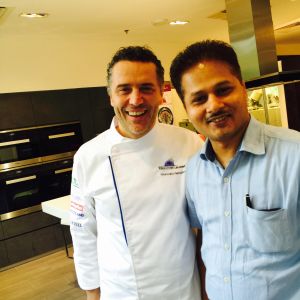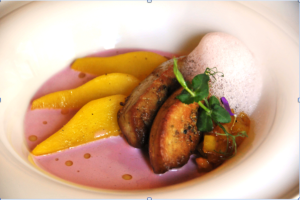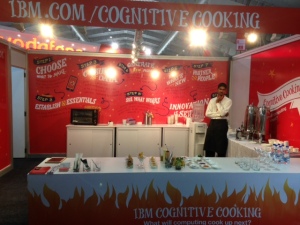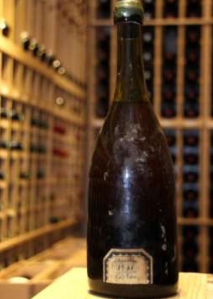Singapore’s annual World Gourmet Summit is, without doubt, one of the premier culinary events on the global calendar. This year, it was my happy privilege to have Saha Signature Indian Restaurant & Terrace Bar participate in this culinary extravaganza.

Gastronomy in Motion — Theme for World Gourmet Summit 2015
Saha was among the Singapore restaurants that showcased the expertise of master chefs from the world over in a series of superb culinary experiences during the World Gourmet Summit from April 6 to May 3. It allowed me the opportunity to meet some amazing chefs and other food professionals, sit down to standout gourmet meals, conduct and attend master classes and also to present what we do at Saha to a wider audience.

Guest Chefs at WGS 2015
The theme for WGS 2015 was ‘Gastronomy in Motion’ and at Saha we created gourmet menus that reflect this concept. The very basis of avant-garde cuisine is to move and move forward, making it a perfect fit with this year’s theme. While there were culinary adventures to be had everywhere, we pulled out something extra special for our guests at Saha. I used the opportunity to create 30 new dishes for the Epicurean Delight and Degustation. Inspired creations included such new age creations as Deconstructed cucumber raita; Textures of lamb comprising pistachio crusted chop, shikampuri kebab and haleem; Kaffir lime flavoured tandoori salmon; Tribute Singapore – a vegetarian creation of stir-fried baby kalian, tofu and water chestnuts, seasoned with cumin, chilli and garlic, Parmesan cheese kulfi with Mango Sorbet and Phirni Lyte.
- Fennel and Cardamom-crusted Foie Gras with Saffron Poached Pears
- Parmesan Kulfi
While we launched the WGS Special menus at Saha on April 6, the events started on April 13 and one of the highlights at Saha was a sparkling Networking Evening on the day, attended by some 50 guests, including celebrity chefs, prominent members of the F&B community, food writers, bloggers and members of the press. We were happy to host Chef Peter Knipp, Principal Creator & Organizer of WGS with his elegant wife Sue Bee, Dr Kwan Lui, Founder of At-Sunrice Global Chefs Academy, Singapore, Master Riesling Wine Maker Dr Lippold, Chef Niklesh Sharma from Malaysia, Master Kaiseki Chef Shinichiro Takagi from Japan Two Michelin Star Chef Giancarlo Perbellini, from Verona and Executive Pastry Chef Cherish Finden from London, amongst others.

Opening Reception & Awards of Excellence
The Awards of Excellence and the Opening Reception where the stars of the culinary world were present was held on April 14 at the swank One Farrer Hotel. While Chef Ivan Brehm of Bacchanalia stole the show by winning 3 awards including Chef of the Year, we celebrated, too, the nomination of our Resident Sous Chef Preetam Sodi for the Young Chef of the Year award. The other highlight of the evening was the spectacular display of over 20 Chocolate & Sugar showpieces by Chef Niklesh Sharma and his team.

Networking Evening at Saha
The signature event at Saha held on April 29 was an evening of Indian Tapas & Grover Wines. We intended it to be an informal and fun evening where guests could mingle while sipping on Grover wine cocktails and nibbling on a series of innovative Indian tapas, small plates and petit desserts. Guests also appreciated my live demo of Fresh Smoked Oysters with Kachumber & Aloo Papri Chaat Modern which was an eye-opener for many about the possibilities of Indian cuisine.

Tapas evening with Grover Wine Cocktails
Master classes, which are integral part of WGS, are events that also make the World Gourmet Summit a bit more special. My Interactive Master class at the Miele Studio Kitchen, showcasing the Modern Indian Cuisine of Saha, was reserved exclusively for Scripps Network and we had a lot of fun together. The master class by Chef Giancarlo Perbellini was not to be missed and I am glad I didn’t. It was a treat to watch this artist at work and to savour his menu of Modern Panzanella with Langoustine, Parmesan crème brulee stuffed ravioli and Signature Tiramisu

Masterclass

Masterclass under way

Chef Giancarlo Parbellini
While the WGS was an endless whirl of culinary activity, I seized the opportunity to experience some world class meals and attend sessions by other renowned chefs on many occasions with Kripal Amanna, Editor & Publisher of Food Lovers Magazine (official media partner from India for WGS 2015). A wonderful experience was the WGS Epicurean Delight Dinner by 2 Michelin Star Chef Tim Raue at Skirt at the W Hotel in Sentosa. His menu included such delights as Carpaccio of Scallop, Elderflower Dressing & Green Melon, Steamed Turbot with Leek & Ginger; Peking duck dimsum, cucumber & spring onion and banana, yuzu & smoked butter.

Chef Tim Raue & Scallop Carpaccio with Elderflower
The Rougie foie gras dinner at Forlino, created by Chef Chris Salans from Mosaic Restaurant, Bali, was another memorable experience of WGS 2015. I marveled at the way this chef redefined this luxury ingredient.

Foie Gras Ice Cream by Chef Chris Salans
I also enjoyed reconnecting with Masterchef Australia host George Calombaris at a special event held in At-Sunrice Global Chefs Academy. We fondly recollected the time we spent together in Bangalore when I hosted him and Chef Gary at special events at Caperberry & Fava in 2013. The opportunity to interact with Chef Jordi Roca & Master Sommelier Josep Roca of the famed El Celler de Can Roca at The Macallan Master of Taste after party in Bacchanalia was another unforgettable experience.

George Calombaris
WGS 2015 was a splendid show and kudos to Chef Peter Knipp and his team for organizing this spectacular showcase of gastronomy for the past 19 years and raising the bar every time. I am thrilled that Saha was part of this prestigious event. The accolades from our VIP guests, celebrity chefs and, of course, our customers at Saha was the best thing about it, assuring us that avant garde Indian cuisine is now ready to take on the world.
http://www.worldgourmetsummit.com/wgs2015/main.php/
http://www.saha.sg


 The restaurant business: My reading is that the F&B business is all set to see a further surge, with growth in all segments, from cafes and bistros to speciality restaurants, quick service outlets and microbreweries. The number of restaurants and bars will go up by atleast 15% to 20%. This sort of growth and a crowded space means chefs and restaurateurs will also be under pressure to create new concepts and innovate to stand out from the clutter. You can also expect more restaurants failing and closing down. It is a great time in India to be in the F&B business as the opportunities and growth potential are big. However one has to be careful because of increasing leasing and manpower costs and lack of trained manpower.
The restaurant business: My reading is that the F&B business is all set to see a further surge, with growth in all segments, from cafes and bistros to speciality restaurants, quick service outlets and microbreweries. The number of restaurants and bars will go up by atleast 15% to 20%. This sort of growth and a crowded space means chefs and restaurateurs will also be under pressure to create new concepts and innovate to stand out from the clutter. You can also expect more restaurants failing and closing down. It is a great time in India to be in the F&B business as the opportunities and growth potential are big. However one has to be careful because of increasing leasing and manpower costs and lack of trained manpower.  Cuisines & Ingredients: Aspects of Latin American, particularly Peruvian cuisine and unique ingredients from the Andean mountains and Amazon basin have been making their impact felt everywhere. One of the original fusion cuisines, Peruvian has absorbed Spanish, African and Chinese and Japanese influences allowing chefs to draw inspiration from it now.
Cuisines & Ingredients: Aspects of Latin American, particularly Peruvian cuisine and unique ingredients from the Andean mountains and Amazon basin have been making their impact felt everywhere. One of the original fusion cuisines, Peruvian has absorbed Spanish, African and Chinese and Japanese influences allowing chefs to draw inspiration from it now.  Think ingredients like Quinoa, Amaranth, Tarwi beans, Purple corn, Oca (tuber) Yuca(Cassava), Aguaje (palm fruit), Cocona (Amazon tomatoes), Sweet Pepino Cactus fruit and many kinds of potatoes (apparently there are 3800 varieties found in Peru). Styles of dishes such as Causa Limeña, Ceviche, Tiradito, Taamales and Pachamanca (earthen oven) are also going to gain in popularity.
Think ingredients like Quinoa, Amaranth, Tarwi beans, Purple corn, Oca (tuber) Yuca(Cassava), Aguaje (palm fruit), Cocona (Amazon tomatoes), Sweet Pepino Cactus fruit and many kinds of potatoes (apparently there are 3800 varieties found in Peru). Styles of dishes such as Causa Limeña, Ceviche, Tiradito, Taamales and Pachamanca (earthen oven) are also going to gain in popularity.  Closer home, I believe regional Indian cuisines are going to become more popular, in a marked departure from the ubiquitous ‘North Indian’ that restaurants have typically served until now. Modern takes on classics from, say, Kerala, of the sort we showcase at Saha, Singapore, will also set the trend. As importing food gets more cumbersome and expensive, chefs now have a compulsion to work with fresh, local and seasonal produce. So, dishes that celebrate local ingredients are likely to make it to the menus this year. On the international restaurant circuit, trend-spotters believe bitter elements will find their way into food. So, chocolate, cocoa and coffee are going to appear on savoury plates.
Closer home, I believe regional Indian cuisines are going to become more popular, in a marked departure from the ubiquitous ‘North Indian’ that restaurants have typically served until now. Modern takes on classics from, say, Kerala, of the sort we showcase at Saha, Singapore, will also set the trend. As importing food gets more cumbersome and expensive, chefs now have a compulsion to work with fresh, local and seasonal produce. So, dishes that celebrate local ingredients are likely to make it to the menus this year. On the international restaurant circuit, trend-spotters believe bitter elements will find their way into food. So, chocolate, cocoa and coffee are going to appear on savoury plates.  Style & Technique: Innovations will continue. I, for one, try to achieve this through understanding new international trends, using new cooking techniques and innovative menu and food presentation. With increasing availability of micro-greens and edible flowers, food presentations will see an increase use of these ingredients. At Fava, for instance, we’re already using homegrown micro-greens that are tossed into salads at the table. Smoking is another technique set to enjoy popularity.
Style & Technique: Innovations will continue. I, for one, try to achieve this through understanding new international trends, using new cooking techniques and innovative menu and food presentation. With increasing availability of micro-greens and edible flowers, food presentations will see an increase use of these ingredients. At Fava, for instance, we’re already using homegrown micro-greens that are tossed into salads at the table. Smoking is another technique set to enjoy popularity.  The bar: I see a definite spike in the number of wine drinkers, with more young people turning to it. Microbreweries will continue to keep their current popularity, especially in cities like Bangalore. As for cocktails, again bold, bitter flavours are going to be in with bartenders experimenting more and more with bitters that go beyond angostura. Health-conscious drinkers are going to be demanding more natural cocktails that use fruit, plant and vegetable juices and extracts.
The bar: I see a definite spike in the number of wine drinkers, with more young people turning to it. Microbreweries will continue to keep their current popularity, especially in cities like Bangalore. As for cocktails, again bold, bitter flavours are going to be in with bartenders experimenting more and more with bitters that go beyond angostura. Health-conscious drinkers are going to be demanding more natural cocktails that use fruit, plant and vegetable juices and extracts.  So, let’s say cheers to that and here’s wishing
So, let’s say cheers to that and here’s wishing






































